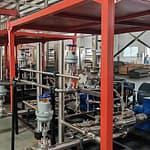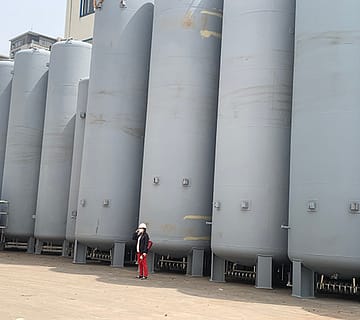Gas cylinders store gases under high pressures.
Gas cylinders can store flammable gases, such as acetylene, and inert gases, such as helium.
Many countries have different color coding systems that classify other gases and types of cylinders. These identification markings indicate essential data about the cylinder’s capabilities, ownership, and inspection history. More information can be seen in the image below.
- Cylinder specification
- Cylinder serial number
- Date of manufacture
- Neck ring identification
- Retest markings
- Bar code label
- Cylinder manufacturer’s inspection marking
- Cylinder tare (empty) weight

It is important to note that there are differences in the terms used to describe gas cylinders from country to country. For example, gas cylinders are sometimes called bottled gas in the United States. In addition, different types of gas cylinders (e.g., industrial, medical, or home use) will have various release valves.
Type of Gas
The three main types of compressed gases that are stored in gas cylinders include:
Liquefied gases can become liquids at average temperatures inside cylinders under pressure. They exist inside the cylinder in a liquid-vapor balance or equilibrium. Typical examples are anhydrous ammonia, chlorine, propane, and carbon dioxide.
Non-liquefied gases are also known as compressed, pressurized, or permanent gases. These gases are not liquid when compressed at average temperatures, even at high pressures. Typical examples are oxygen, nitrogen, helium, and argon.
Dissolved gases are volatile. The most common example is acetylene, which can explode even at atmospheric pressure. Acetylene cylinders are fully packed with an inert, porous filler saturated with acetone to prevent explosions. As acetylene is added to the cylinder, the gas dissolves in the acetone making the acetylene solution stable.
State of Gas (Gas Cylinders store gases)
Gases in a compressed gas cylinder can be toxic, flammable, oxidizing, corrosive, and inert. Special care should be taken when dealing with compressed gas cylinders, such as an argon gas cylinder, to prevent falling and breaking and to ensure proper ventilation. A gas cylinder rack or cabinet is typically used to safely and conveniently store gas cylinders.
Material of Construction
Gas cylinders can be made from aluminum, steel, alloys, and composite materials. Mechanical strength, corrosion resistance, and impact resistance are critical factors in determining the material used. Carbon fiber composite cylinders can be very light due to the high tensile strength of carbon fiber but are more challenging to manufacture.
A commonly used type of gas cylinder is a propane tank. Propane is a gas used in homes, farms, businesses, and industry. Propane is typically used for heating and must be stored in specially designed-propane tanks. Some gases that are very unstable in their confined form, such as acetylene, require specially made gas cylinders (e.g., an acetylene gas cylinder) to reduce the hazards from shock and heat.

Gas cylinders have a valve to control the release of the gases. A cap, collar, or neck ring commonly protects the valve assembly from damage when the gas is unused. When dispensing gas from a cylinder, a pressure regulator assembly controls the gas flow at the desired pressure.
Gas Cylinders store gases
Gas cylinders are used in various industries, including food processing, water treatment, and laboratory. T ey are most commonly found in the manufacturing and medical industries. In manufacturing, gas cylinders are used for storing fuel for heating systems, vehicles, and torches and storing the energy source for power tools or assembly line machinery.
Medical gas cylinders provide supplemental oxygen, nitrous oxide (anesthetic functions), nitrogen (surgical tools), and carbon dioxide (inflate tissue).
Regulations and Standards (Gas Cylinders store gases)
The International Organization for Standardization (ISO) technical committee responsible for developing standards for gas cylinders and fittings is ISO/TC 58. Notable standards include BS EN ISO 102286 for gas cylinder terminology and BS EN ISO 11114-4 for gas cylinder transportation.
In the United States, compressed gases fall under the United States Department of Transportation (US DOT) regulations outlined in Title 49 Section 173 of the Code of Federal Regulations (49 CFR 173). These regulations require the use of hazardous materials placards during shipment.
The Occupational Safety & Health Administration (OSHA) also maintains gas cylinder standards.












No comment